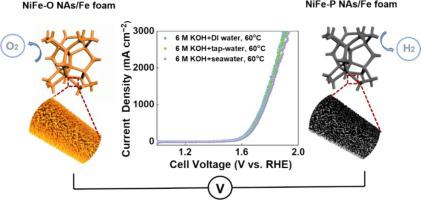Robust and efficient Iron-Based electrodes for hydrogen production from seawater at high current density above 1000 mA cm−2
IF 13.2
1区 工程技术
Q1 ENGINEERING, CHEMICAL
引用次数: 0
Abstract
The implementation of cheap iron-based catalysts for seawater electrolysis at high- current–density offers an economical and sustainable solution for industrial hydrogen production in near future. However, Fe-based electrodes suffer from poor intrinsic activity and corrosion resistance in seawater, resulting in unsatisfactory seawater splitting performance. Here, we reported the scale-up fabrication of whole-Fe-based electrodes (NiFe-X (X = O, P) NAs/Fe foam) by facile soaking-phosphating. Surface active layers exhibit enhanced corrosion resistance compared to bare Fe foam, and trace Ni modification lowers reaction energy barriers of cathodic NiFeP and in-situ generated anodic NiFeOOH, respectively. Thus, NiFe-P||NiFe-O pair only requires 1.93 V to deliver 3000 mA cm at 6 M KOH, 60 °C for overall seawater splitting, and works stably for 200 h at 1000 mA cm. Furthermore, NiFe-X (X = O, P) NAs/Fe foam show impressive adaptation to fresh water/tap water/seawater and all kinds of renewable energies, presenting excellent flexibility for various environmental applications and scenarios.

稳健高效的铁基电极,用于在 1000 mA cm-2 以上的高电流密度条件下从海水中制氢
采用廉价的铁基催化剂在高电流密度下进行海水电解,为不久的将来工业制氢提供了一种经济、可持续的解决方案。然而,铁基电极在海水中的本征活性和耐腐蚀性较差,导致海水分离性能不理想。在此,我们报告了通过简单的浸泡-磷化法放大制备全铁基电极(NiFe-X(X = O、P)NAs/Fe 泡沫)的过程。与裸露的泡沫铁相比,表面活性层表现出更强的耐腐蚀性,痕量镍修饰分别降低了阴极NiFeP和原位生成的阳极NiFeOOH的反应能垒。因此,NiFe-P||NiFe-O 对在 6 M KOH、60 °C 的条件下只需要 1.93 V 的电压就能提供 3000 mA cm 的电流,并能在 1000 mA cm 的条件下稳定工作 200 小时。此外,NiFe-X(X = O、P)NAs/Fe 泡沫对淡水/自来水/海水和各种可再生能源的适应性令人印象深刻,为各种环境应用和方案提供了出色的灵活性。
本文章由计算机程序翻译,如有差异,请以英文原文为准。
求助全文
约1分钟内获得全文
求助全文
来源期刊

Chemical Engineering Journal
工程技术-工程:化工
CiteScore
21.70
自引率
9.30%
发文量
6781
审稿时长
2.4 months
期刊介绍:
The Chemical Engineering Journal is an international research journal that invites contributions of original and novel fundamental research. It aims to provide an international platform for presenting original fundamental research, interpretative reviews, and discussions on new developments in chemical engineering. The journal welcomes papers that describe novel theory and its practical application, as well as those that demonstrate the transfer of techniques from other disciplines. It also welcomes reports on carefully conducted experimental work that is soundly interpreted. The main focus of the journal is on original and rigorous research results that have broad significance. The Catalysis section within the Chemical Engineering Journal focuses specifically on Experimental and Theoretical studies in the fields of heterogeneous catalysis, molecular catalysis, and biocatalysis. These studies have industrial impact on various sectors such as chemicals, energy, materials, foods, healthcare, and environmental protection.
 求助内容:
求助内容: 应助结果提醒方式:
应助结果提醒方式:


